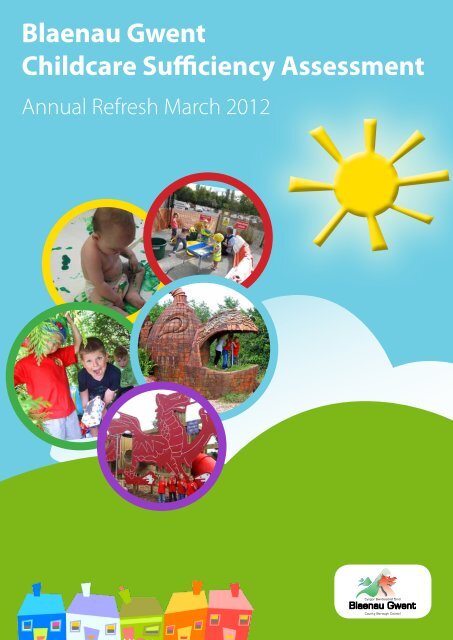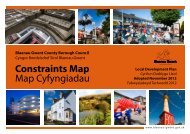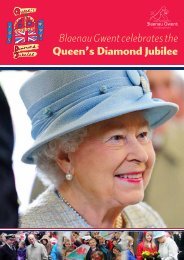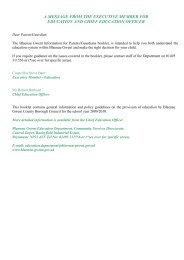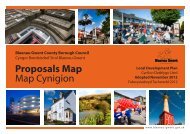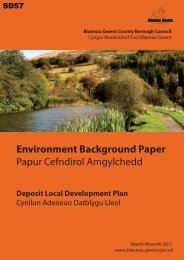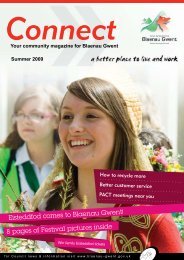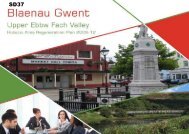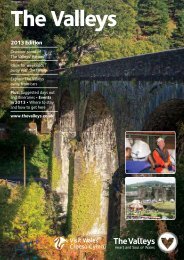Blaenau Gwent Childcare Sufficiency Assessment
Blaenau Gwent Childcare Sufficiency Assessment
Blaenau Gwent Childcare Sufficiency Assessment
You also want an ePaper? Increase the reach of your titles
YUMPU automatically turns print PDFs into web optimized ePapers that Google loves.
<strong>Blaenau</strong> <strong>Gwent</strong><strong>Childcare</strong> <strong>Sufficiency</strong> <strong>Assessment</strong>Annual Refresh March 2012
Executive Summary<strong>Blaenau</strong> <strong>Gwent</strong> County Borough Council carried out its full <strong>Childcare</strong><strong>Sufficiency</strong> <strong>Assessment</strong> in March 2011, this report is the Annual Refresh 2012of the <strong>Sufficiency</strong> <strong>Assessment</strong>.Under the <strong>Childcare</strong> Act 2006, Local Authorities have a statutory duty tosecure sufficient childcare for the needs of working parents/carers in theirarea for children up to 14 years of age or 18 in the case of children withdisabilities.A core element of this duty is to complete a <strong>Childcare</strong> <strong>Sufficiency</strong> <strong>Assessment</strong>every three years, with an Annual Refresh, which assesses the supply of, anddemand for, childcare in the local authority and identifies any gaps inprovision. The statutory guidance on undertaking a <strong>Childcare</strong> <strong>Sufficiency</strong><strong>Assessment</strong> also recommends that an action plan is also developed to helpaddress the identified sufficiency gaps.The childcare market in <strong>Blaenau</strong> <strong>Gwent</strong> is still relatively new. Until 10 yearsago there were only 114 childcare places within the Authority and no qualityassurance procedures, workforce development and other schemes relating tothe childcare non-maintained early years sector. The Authority now has 1491registered childcare places and a record 83 childcare providers.Despite this success, according to the <strong>Blaenau</strong> <strong>Gwent</strong> <strong>Childcare</strong> <strong>Sufficiency</strong><strong>Assessment</strong> 2011, there is still room for growth in the sector within theAuthority, as many parents stated in our consultation 2010, that they were notyet using childcare because they were unaware of early years opportunities,funding and the benefits of using childcare and therefore used parents andextended family as the predominant child carers. Awareness Raising isPriority 1 in the 3 year Action Plan.The <strong>Blaenau</strong> <strong>Gwent</strong> <strong>Childcare</strong> <strong>Sufficiency</strong> <strong>Assessment</strong> (CSA) 2011 provides adetailed analysis of supply of childcare in <strong>Blaenau</strong> <strong>Gwent</strong>. Although thechildcare market is a rapidly growing sector in <strong>Blaenau</strong> <strong>Gwent</strong>, it is a sectorthat faces many challenges in relation to sustainability. The settings are nonmaintainedand have a reliance on parents fees with some receive minimalgrant funding to supplement these fees. <strong>Blaenau</strong> <strong>Gwent</strong> also has one of thehighest employment rates of all Authorities in Wales which also in turnimpacts of demand for childcare.The above factors all contribute towards the level and intensity of support thatis required for the childcare sector in <strong>Blaenau</strong> <strong>Gwent</strong> to ensure its success.As part of the <strong>Childcare</strong> <strong>Sufficiency</strong> <strong>Assessment</strong> Annual Refresh 2012/2013,key statistics have been identified and reviewed in light of their potentialimpact on the childcare market in <strong>Blaenau</strong> <strong>Gwent</strong>.The demand side of the CSA 2011 predicted a slight increase in the birth ratefor 2012, this was a correct prediction with the number of births from 1 stJanuary 2011 to 31 st December 2011 standing at 794 (Aneurin Bevan HealthBoard data). An increase of 29 births on 2010 data. This implies the latestdata demonstrates that birth rates in <strong>Blaenau</strong> <strong>Gwent</strong> are slowly beginning togo up again.22
In terms of live births by sub Local Authority area no new data is available andthis will not be available until the census figures are available for 2011. Nonew data is available for live births for teenage parents by sub Local Authorityarea, although the overall number of births within <strong>Blaenau</strong> <strong>Gwent</strong> aredecreasing for this group.Supply data shows that there is an increase once again in the number ofregistered childcare settings in <strong>Blaenau</strong> <strong>Gwent</strong> which went up in 2011/12 by129 places. The growing number of childcare places shows that awareness ofchildcare in <strong>Blaenau</strong> <strong>Gwent</strong> is raising and the culture is shifting, beyond that ofusing family and friends as primary childcarers.The previous <strong>Childcare</strong> <strong>Sufficiency</strong> <strong>Assessment</strong> 2011 reported that in March2011 there were 218 places with day nurseries and now there are 260. Therewere 213 places at holiday clubs and there are now 241 and there were 516places with playgroups and meithrins and there are now 564. This shows thatthere has been an increase in the total number of registered settings and alsovacancy rates overall have dropped. This shows that the economic downturnand recession has not yet had a detrimental effect on the childcare market in<strong>Blaenau</strong> <strong>Gwent</strong>. The childcare market in <strong>Blaenau</strong> <strong>Gwent</strong> has risen year onyear for 10 years and still continues to do so.The childcare roadshows and marketing programme in 2011 were designed toraise awareness of childcare and the associated benefits with parents, mayhave had an effect on the number of parents requiring childcare and/or theamount of childcare; meaning that more childcare is needed overall.In terms of the spread of childcare, it is useful to consider the location ofregistrations and resignations across the Authority. Although a few settingshave resigned childcare registration there has been an increase overall. Thisdata shows that the current distribution of childminders and settings is fairlysimilar to that reported previously. However, some further consideration mayneed to be given to the low numbers of childminders in Blaina andCwm/Waunlwyd, although this is covered in the 3 year Action Plan.The economic downturn and recession may have had an effect on the numberof parents requiring childcare overall in the UK but seems to have little effecton BG with the market still growing. However, the current recession is clearlyhaving a short term impact in terms of the affect locally on jobs and businessprofitability. The longer term economic vision for the Council, as set out in theRegeneration Strategy and Action Plan, remains unchanged. Potentiallytransformational improvements will continue, such as the opening of theLearning Campus in September 2012, the dualling of the Heads of the Valleysroad, the focus on local enterprise development, further progress on keyprojects at the Works, and the availability of European Structural Funds for theperiod 2014-2020 which should all impact on the demand for high qualitychildcare.There are still plenty of vacant places in <strong>Blaenau</strong> <strong>Gwent</strong> therefore, it is impliedthat there is sufficient childcare available in <strong>Blaenau</strong> <strong>Gwent</strong> to meet currentdemand at this time but we must keep developing the sector inline with theincrease in demand which occurs each year.33
SUMMARYPopulationThe highest concentrations ofchildren and young people continue inthe West (Tredegar) and North/North-East (Brynmawr and Nantyglo) of theBorough.Birth rates are rising slightly onceagain.Demand for childcareAwareness raising ofchildcare/childcare roadshows andmarketing schemes, that have beenevaluated, have had an impact ontake up of childcare places inparticular sessional places for 2-3year olds.Children funded via the AuthoritiesAssisted Places <strong>Childcare</strong> Schemerose from 111 in 2010/11 to 131 in2011/12, this in turn has impacted ondemand for childcare and also has animpact on vacancy rates andsustainability of settings.There was a 2% increase in childrenwith ALN and disabilities accessingchildcare.43 children were able to accesschildcare with 121 support throughthe scheme.Demand for Welsh Medium <strong>Childcare</strong>is still low despite intensivemarketing.Flying Start – the roll out of FlyingStart will mean increased amount ofchildcare places needed for 2 and 3year olds from 2013.Supply of <strong>Childcare</strong>While there have not been majorchanges to the supply of all types ofchildcare, the following are thenotable developments in 2012:There was a net gain of 129 childcareplaces.Take up of after school and holidayprovision increased although thereare still a large amount of vacanciesin this area.5 childminders deregistered in Blainain the past year and this will have tobe addressed, however there areother childcare options in plentifulsupply in this area.Other key developmentsimpacting ondemand for childcareWelfare benefits changes for loneparents have started to impact ondemand in 2009.Demand may change in response tochanging prices and on childcarerequirements for children who speakWelsh or are bilingual.The economic recession hasimpacted on Businesses andemployment in <strong>Blaenau</strong> <strong>Gwent</strong> butnot especially on the childcare sector.“The Works” development will bewatched closely to ascertain itsimpact on demand for childcare,although childcare has been plannedfor the site.44
Acknowledgements<strong>Blaenau</strong> <strong>Gwent</strong> County Borough Council would like to thank colleagues inpartner organisations and agencies for their contributions to the AnnualRefresh 2011/12.Compiled by <strong>Childcare</strong> Strategy Team, <strong>Blaenau</strong> <strong>Gwent</strong> County BoroughCouncil, Education and Leisure Services DirectorateIf you have any comments concerning this report please contactCeri.Bird@<strong>Blaenau</strong>-<strong>Gwent</strong>.gov.uk55
Contents Page1. Introduction 92. Review of the Local <strong>Childcare</strong> Market 102.1 Demand: - Factors affecting demand for childcare 102.2 Background 102.3 Birth Data 112.4 Employment Data 122.5 Housing Developments 152.6 Child Poverty Initiatives 162.7 Demand Conclusion 193 Review of Supply of <strong>Childcare</strong> 203.1 Wards within <strong>Blaenau</strong> <strong>Gwent</strong> County Borough Council– Map of Wards 213.2 Analysis of Supply Summary 223.3 Number of registered providers 223.4 Total free provision 234 Number of places 234.1 Number of registered places by setting type 235. Vacancies Places by age range 245.1 Total number of vacancies 0-17 years 245.2 Comparison figures 2010-2011 265.3 Breakdown by ward places vacancies 0-7 Years 275.4 Breakdown by ward places vacancies 8-17 Years 285.5 Breakdown of ward vacancies places by Age Categoryand Languages Spoken 296 Funded Places 326.1 Nursery Places for 3 and 4 Year provision 3266
7 Quality 347.1 Quality Assurance 347.2 Pre-School Playgroup and Day NurseryQuality Assurance 357.3 Out of School Club Quality Assurance Scheme 377.4 National Association Childminding Association -<strong>Blaenau</strong> <strong>Gwent</strong> Quality Network 378. Workforce Development 389. Community Focus School <strong>Childcare</strong> Grant 3910. Welsh Medium <strong>Childcare</strong> 4011. BME/Ethnic Minority Groups 4212. Vulnerable Children 4213. Children with Disabilities and Additional LearningNeeds 4313.2 Special Needs – Areas of Experience 4414. Flying Start 4515. Further consultation in 2011/2012 4615.1 <strong>Childcare</strong> Providers 4615.2 Professionals including Schools 4716. Conclusion 4917. Appendices 5017. Implementation of the action plan 5177
1. IntroductionThe <strong>Childcare</strong> Act 2006 requires every Local Authority in Wales to conduct a<strong>Childcare</strong> <strong>Sufficiency</strong> <strong>Assessment</strong>. The aim of this assessment is to provide<strong>Blaenau</strong> <strong>Gwent</strong> County Borough Council with the information it needs toidentify gaps in the childcare market and plan the steps to secure sufficientchildcare places. In this context, ‘sufficient’ means having the right type andthe right volume of childcare places to meet the needs of all parents/carers inthe local community, but with a particular focus on meeting the needs offamilies with children with disabilities, Welsh speaking households and thosewho are in work or who are seeking work.The Welsh Government requires each Local Authority to provide a full<strong>Childcare</strong> <strong>Sufficiency</strong> <strong>Assessment</strong> every 3 years (2008, 2011 etc) with a“Refresh” of the data published on an annual basis.In April 2011, <strong>Blaenau</strong> <strong>Gwent</strong> County Borough Council published its last<strong>Childcare</strong> <strong>Sufficiency</strong> <strong>Assessment</strong> 2011-2014 with its 3 year strategic plan.This set out the findings regarding registered childcare for children up to theage of 14 or up to 18 with disabilities within the Authority.This document is the Annual Refresh of the CSA for 2012.A summary of the full <strong>Childcare</strong> <strong>Sufficiency</strong> <strong>Assessment</strong> 2011, Action Planand Summary Refreshes are all available on www.blaenau-gwent.gov.uk88
2.0 Factors affecting demand for childcare2.1 Background<strong>Blaenau</strong> <strong>Gwent</strong> has historically had the lowest amount of childcare provisionin Wales but the childcare sector in <strong>Blaenau</strong> <strong>Gwent</strong> has expanded by over1300% in the past ten years and has probably seen the fastest childcareexpansion of all Local Authorities. To meet the demands of this intense, rapidexpansion we constantly have to develop extra childcare places and recruitand train new staff.In the CSA 2011 registered, childcare places in <strong>Blaenau</strong> <strong>Gwent</strong> had increasedfrom 114 places in 2002, to 1,362. There has been a further 129 placescreated in 2011/12 and <strong>Blaenau</strong> <strong>Gwent</strong> now has 1,491 registered childcareplaces. This demonstrates the use of childcare by the community of <strong>Blaenau</strong><strong>Gwent</strong> is now more common.Settings in <strong>Blaenau</strong> <strong>Gwent</strong> are fortunate because although the country is ineconomic recession the sector in <strong>Blaenau</strong> <strong>Gwent</strong> is still experiencing growth,this may because of an increased availability of registered childcare orconstant knowledge and awareness raising and marketing of the variousopportunities around childcare, although it must be stated that the applicationsto Assisted Places has increased.We must not be complacent about the economy and the setting’s businessinfrastructure must be supported throughout these difficult times so growthcontinues in our sector. If the sector is not supported through this difficult timewe could be facing a situation where we loose settings and undo all the hardwork we have invested into this sector over the past ten years.As an Authority we need to build childcare places inline with demand. It is avery fine balancing act as surplus places cost money so we need to buildplaces inline with demand. For this reason there is a need for developmentwork to sustain existing childcare levels and build in areas where there aregaps.99
Preschool ProvisionAbertillery ward – no planning neededBadminton ward - develop preschool provisionBeaufort ward – Mini Me’s/Twinkle Tots newly openedBlaina ward – Suffice provision in areaBrynmawr – Welsh medium preschool to be developedCwm – Mini Allsorts relocating – extra spacesCwmtillery – Will become a Flying Start area - expand Mini Me playgroupEbbw Vale North – will become a Flying Start area – capital bid inEbbw Vale South – will become a Flying Start areaGeorgetown – planned preschool provision – difficulty in venueLlanhilleth – expansion of Flying Start area – capital bid inNantyglo – Suffice provision in wardRassau – Will become a Flying Start area – expand Acorns PlaygroupSirhowy – expansion of Flying Start area – capital bid inSixbells – proposed MeithrinTredegar Central and West – proposed Meithrin at Deighton PrimaryOut of school clubsThe market is responding to growth in demand but still many vacancies in thisarea and more promotion/awareness raising needed.2.3 Demographic DataNationally the childcare sector has been relatively robust during the recessionand <strong>Blaenau</strong> <strong>Gwent</strong> is no different. The childcare market is still at a period ofgrowth. <strong>Childcare</strong> providers are reporting some parents may have reducedtheir hours and some are not paying so much in advance but generally themarket is very buoyant.The current recession is clearly having a short term impact in terms of theaffect locally on jobs and business profitability. However, the longer termeconomic vision for the Council, as set out in the Regeneration Strategy andAction Plan, remains unchanged. Potentially transformational improvementswill continue, such as the opening of the Learning Campus in September 2012, the dualling of the Heads of the Valleys road, the focus on local enterprisedevelopment, further progress on key projects at the Works, and theavailability of European Structural Funds for the period 2014-2020.2.4 Employment dataWelfare to work agendaThere has been little impact on the <strong>Blaenau</strong> <strong>Gwent</strong> childcare market to date,as a result of direct pressure from support to individuals as the welfare to workagenda came into bearing in April 2011. It is envisaged that more clients whohave multi layered needs will present themselves/be referred from supportagencies, as the agenda embeds itself. This may have a growing impact forchildcare in 2012, and need must be closely monitored through our EYDCPlinks with Jobcentre Plus. The welfare to work agenda is marked by majorchanges in levels of benefit payment made and assessment regimes for1111
particular benefits; most extensive impacts are likely to be experienced inthose areas with highest levels of existing benefit claiming.There is potential for increase in demand for childcare particularly, as a resultof changes to welfare benefits for lone parents. According to the ONS AnnualPopulation Survey, the rate of unemployment in <strong>Blaenau</strong> <strong>Gwent</strong> remainedreasonably steady over a two year period from July 09 to June 2011 – fallingslightly from 13.8% to 13.6% of the economically active population. However,this is considerably higher than the all-Wales figure, which rose slightly from8.1% to 8.5% over the same period.<strong>Blaenau</strong> <strong>Gwent</strong> Family Information Service reports that calls from parentsasking for advice because of changes in welfare reform have remainedreasonably static over the last two/three years. Data collected from Genesisand School gates employment initiatives for parents in <strong>Blaenau</strong> <strong>Gwent</strong> confirmthis. It is estimated changes are to come, with the lowering to 5 years fortransition from IS to JSA, and more work focused interviews from when thechild is 1 year, will have more of an impact on demand for childcare.The local economy is not providing enough employment opportunities for allage groups across the economy as a whole. In <strong>Blaenau</strong> <strong>Gwent</strong> and thevacancy rate is 1 to every 13 JSA claimants. Across all areas, locally andnationally numbers of notified vacancies have fallen considerably with levelsin 2010 and 2011 being the lowest since 2007.Quarterly JSA figures released by the Department of Work and Pensionsreveal that the proportion of people claiming Job Seekers Allowance roseslightly from 6.5% of the working age population in May 2010 to 6.8% in 2011.In comparison, the Welsh average rose from 3.6% to 3.7% over the sameperiod.Job Seekers Allowance (JSA). Incapacity Benefit (IB)/Employment Support Allowance(ESA) Count by Local Authority.(<strong>Blaenau</strong> <strong>Gwent</strong>, Caerphilly, Merthyr Tydfil and RCT)LA<strong>Blaenau</strong><strong>Gwent</strong>JSADec071780JSA%Wales 4.5%UK 4.1%JSAFeb11JSAJuly11JSAAug11JSASept11JSAOct 11JSANov11JSADec11JSAJan 12JSAFeb122928 3033 3140 3171 3226 3233 3263 3416 3431(+15)JSA %W agepopJan12IB/ESAMay2011IB/ESAAugust20117.9% 5950 594013.7%In these areas JSA has risen by 200 in February. IB/ ESA has fallen by 100between May 2011 and August 2011.1212
daycare, sessional, wraparound, out of school childcare has already beenplanned and features in the 3 year strategic childcare action plan.Other areas that may impact on demand for childcareThere are no army/forces in <strong>Blaenau</strong> <strong>Gwent</strong>, the nearest is in Brecon over 12miles away. Our FIS survey to childcare providers tells us that they havestated that this base has no impact on childcare in <strong>Blaenau</strong> <strong>Gwent</strong>.There are also no HM Prisons within <strong>Blaenau</strong> <strong>Gwent</strong>.2.6 Child Poverty InitiativesA high proportion of working age adults claim some kind of benefits higherthan the Wales average, which in turn has a big impact on poverty anddeprivation levels within the Borough, presenting a number of challenges for<strong>Blaenau</strong> <strong>Gwent</strong>. According to the Welsh Index of Multiple Deprivation, 43% oflower super output areas in <strong>Blaenau</strong> <strong>Gwent</strong> are in the most deprived fifth ofWales. As a result there is a comparably low level of annual householdincome (£25,800 compared to £30,600 for Wales). A recent Estyn inspectionhighlighted <strong>Blaenau</strong> <strong>Gwent</strong>’s strategy for skills and economic regeneration asan area of good practice helping parents to access skills training and startnew businesses, however recent research undertaken as part of Families FirstPioneer has identifed that there will be significant impact on 16-25 year oldsarising form Welfare Reform and external economic factors.Percentage of Children Living in Poverty 2010(Number of children living in workless households)35.0%30.0%25.0%Percentage20.0%15.0%LAWelsh Average10.0%5.0%0.0%Isle of AngleseyGwyneddConwyDenbighshireFlintshireWrexhamPowysCeredigionPembrokeshireCarmarthenshireSwanseaNeath Port TalbotBridgendThe Vale of GlamorganRhondda Cynon TafMerthyr TydfilCaerphilly<strong>Blaenau</strong> <strong>Gwent</strong>TorfaenMonmouthshireNewportCardiffLocal AuthorityThe Children and Families (Wales) Measure 2010 places a duty on WelshMinisters to publish a new Child Poverty Strategy for Wales.This new Child Poverty Strategy for Wales sets out the vision and strategicobjectives for reducing child poverty. The three new strategic objectives fortackling child poverty are to:1515
1. reduce the number of families living in workless households;2. improve the skills of parents and young people living in low incomehouseholds so they can secure well-paid employment; and3. reduce inequalities that exist in health, education and economicoutcomes of children and families by improving the outcomes of thepoorest.The strategy aims to give a clear account of what the Welsh Government canachieve in helping to reduce poverty during the next three years (2011 to2014). The strategy also responds to the changing UK fiscal climate, and setsout a distinctive Welsh approach to the provision of public services that canaddress the long-term root causes of poverty, and alleviate some of the moredamaging impacts of poverty in the short term.Quality childcare has an important role in tackling child poverty and it isimportant that Government is aware of the work of childminders and how thiswork is helping children and families across Wales.The strategy contains the following section on childcare‘We (The Assembly Government) know that there are some significantchallenges if we are going to provide the right type of childcare, in the rightplace, and of a quality that will support the development of children in theearly years. A priority for this Child Poverty Strategy and Delivery Plan mustbe to promote accessible, affordable and high quality childcare – which offersa dual benefit for employment and early years development.The Child Poverty Strategy highlights the commitment too;-• Develop a strategic and coherent approach to childcare policy in Walesto provide integrated solutions to improve the supply and diversity ofchildcare provision. This will include developing the childcareinfrastructure by increasing and improving the range of provision.• Close the gap between demand and supply for childcare in Wales.• Work with Local Authorities and the Sector Skills Council to developand enhance the childcare workforce in Wales.• Continue to promote the availability of the childcare element of theWorking Tax Credit and where possible, to extend the reach of thescheme to parents with older children.• Help schools to build on existing provision and consider what additionalservices or activities that they and their partners might develop,particularly in the field of childcare.• Continue to support the development of out of schools care inCommunity Focused Schools and the development of activities forchildren and young people as part of that childcare package.Community Focused Schools can provide important wraparoundchildcare.1616
The key Child poverty initiatives are;-Flying StartFlying Start is targeted at 0-3 year olds in the most disadvantagedcommunities in Wales. It aims to create positive outcomes in the medium andlong term. It is a prescriptive programme, based on international evidence ofwhat works.What it means in practice• free quality part-time childcare for 2-3 year olds• an enhanced Health Visiting service (where the Health Visitor caseloadis capped at 110 children)• access to Parenting Programmes• access to Language and Play sessions.* Please see Flying Start plan of this plan.Families First Deputy Minister for Children Huw Lewis announed Wales“Families First” project as part of the Welsh Government’s commitment tosupport families and tackle child poverty.The aim of the project is to lead the way in improving the delivery of servicesto families across Wales, especially those living in poverty, as set out in theAssembly Government’s draft Child Poverty Strategy. The AssemblyGovernment wants to rapidly identify best ways of working and share this onan all –Wales basis.Communities 1 stThe Communities First Programme aims to address the needs of familiesandchildren living in our most deprived (Communities First) areas, experiencingmultiple deprivation. There is a wide range of work being undertaken targetedat supporting children and young people through Communities First and theprogramme exists to provide local people with opportunities to play an activerole in shaping the future of their community and engage mainstream servicessuch as Families First proposals.2.7 Conclusions from Demand;-What does the demand tell us now in 2012/2013?In conclusion, the data that has been analysed from the demand exercise tellsus there are no new emerging gaps for childcare provision in <strong>Blaenau</strong> <strong>Gwent</strong>that have not already been planned for.Does this reinforce gaps on previous gap analysis?1717
Yes there are no new gaps to date and this annual refresh enforces thecurrent 3 year action plan.In general are gaps widening or getting smaller?Gaps are getting smaller year on year because of the intense about of workbeing carried out in the childcare sector by the EYDCP, and the rate thatregistered childcare places are increasing.New gaps emerging?No, the development of “The Works” which will see major parts of its workcompleted in 2012/13 was already planned for in the 3 year Strategic Plan.Work does need to be carried out to encourage new childminders to theBlaina/Cwm/Waunlwyd area but sustainability must also be looked at as thereare so many other childcare options available.3.0 Review of Supply of <strong>Childcare</strong>This analysis of the supply of childcare is based on data collected fromproviders and held at <strong>Blaenau</strong> <strong>Gwent</strong> Family Information Service as at 31 stDecember 2011 unless otherwise stated.In order to carry out this refresh, all registered childcare providers have beengiven the opportunity in reviewing the information we currently hold on them,allowing them to provide comments on the childcare market in <strong>Blaenau</strong> <strong>Gwent</strong>for this analysis.It shows data relating to both provision registered with CSSIW andunregistered provision.Data is presented for <strong>Blaenau</strong> <strong>Gwent</strong> Borough as a whole as well as localities.Further details are available on request.1818
3.1 Wards within <strong>Blaenau</strong> <strong>Gwent</strong> County Borough Council – Map of Wards<strong>Blaenau</strong> <strong>Gwent</strong> County Borough Council localitiesFigure 11919
3.2 Analysis of Supply SummaryThere is a total of 83 registered providers located across <strong>Blaenau</strong> <strong>Gwent</strong>County Borough. All settings are registered with CSSIW (Care and SocialServices Inspectorate), a fee is payable and therefore all parents accessingthese provisions are eligible to claim the <strong>Childcare</strong> element of the Tax Credit.3.3 Number of registered providersChart 1 indicates that there were 83 CSSIW registered providers in <strong>Blaenau</strong><strong>Gwent</strong> County Borough Council as of the 31 st December 2011, an overallincrease of 3 settings since 31 st October 2010 (this is offset by deregistrations).Of these:• 40 (48%) are childminder settings an overall increase of 1 setting• 6 (7%) are private day nurseries an overall increase of 1 setting• 16 (20%) are pre-school playgroups an overall increase of 1• 9 (11%) are holiday clubs and overall increase of 1 setting• 12 (14%) are out of school clubs, of these 10 provide after school care,with an overall increase of 1 and 2 providing breakfast club provision,with no overall increase.• 6 provisions provide wrap-a-round care an with an overall increase of 1settingRegistered Settings 2010 and 201145403530252015105020102011Day NurseryPre School PlaygroupChildminderHoliday ClubBreakfast ClubsAfternoon ClubsCrecheChart 1 indicates the overall number of settings in 2010 and 20113.4 Total Free ProvisionIn addition there are• 24 Free Breakfast Clubs• 30 Early Years education providers, of these 3 settings are in the nonmaintainedsector and 27 are located in schools• 6 registered Flying Start Settings2020
4 Number of places4.1 Total number of registered places by setting type within the boroughChart 2Provider TypeRegistered Places2010Registered Places2011After School Club 235 261Breakfast Club 45 45Childminder 162 168Creche 27 0Day Nursery 218 260Holiday Club 213 241Meithrin/Playgroup 464 516Total 1364 1491Registered Places 2010 and 20116005004003002001000Registered Places 2010Registered Places 2011After School ClubBreakfast ClubChildminderCrecheDay NurseryHoliday ClubMeithrin/PlaygroupChart 2 indicates the total number of CSSIW registered places by settingtype. There are a total number of 1491 places compared to 1364 in 2010,an increase of 127 places (8.5%).2121
Number of Registered Places15001491140013001364Number of RegisteredPlaces12002010/2011 2011/2012This figure also takes into account settings offering 2 sessions per day (e.g. a setting registered for 24 children mayhave 2 sessions 1 in the morning and 1 in the afternoon therefore this figure has been calculated as 48 children).OOSC data includes after school clubs in day nursery settings. Holiday clubs includes data for holiday clubs in daynursery settings. 14-17 places are available in all settings and available on an ad hoc basis providing there is fundingavailable for additional staff.Chart 3 above indicates the overall total increase of registered childcareplaces within the borough from 2010/11 to 2011/12.Section 5 - Vacancies Places by age range Section5.1 Total Number of vacancies for children aged 0-17 yearsThis section addresses the total number of vacancies within both English andWelsh registered settings, broken down by age range and overall registeredvacancies. The figures show actual numbers collected from registeredsettings on 31 st December 2011 by The Family Information Service. Thesefigures will differ from the number of places offered in section 3 as it allows forboth part-time places and children over the age of 8 years.Note: The figures below do not include early years education places orfree breakfast clubs• 880 total vacancies in the age range 0-17 years.2222
Chart 4 Number of vacancies for childrenaged 0-17Political WardDescriptionProviderTypeDescriptionOver 18MonthsTo 5YearsOver 5Years -Under 8YearsOver8yrs -Under14 YearsUnder 18MonthsTotalAbertillery Total 39 17 17 3 76Badminton Total 6 5 2 5 18Beaufort Total 2 1 1 1 5Blaina Total 51 43 59 7 160Brynmawr Total 25 35 29 5 94Cwm Total 11 11 10 1 33Cwmtillery Total 1 19 19 1 40Ebbw ValeNorthEbbw ValeSouthTotal 21 20 20 1 62Total 6 1 1 6 14Georgetown Total 4 1 3 1 9Llanhilleth Total 9 6 4 4 23Nantyglo Total 15 14 13 3 45Rassau Total 65 49 33 4 151Sirhowy Total 19 3 3 24 49Six Bells Total 5 5 2 3 15TredegarCentral andWestTotal 53 16 16 1 86Total 332 246 232 70 880NB the above figure will differ from that of total vacancies as it incorporates part time vacancies and includingfull time vacancies.2323
5.2 Comparison Figures 2010 – 2011Chart 5 Changes in <strong>Childcare</strong> since 2011Provision FIS ProviderNameDate RegisteredDe-RegisteredNewRegistrationDe -RegistrationDay NurseryButterflies DayNurseryDec-11 50CrecheDinky Dragons Apr-11 12Leaps and Bounds Apr-11 15Childminders Keren Price Apr-11 5Claire Watkins May-11 3Belinda Taylor Jun-11 3Laura Edwards Dec-11 4Michelle Robins Dec-11 3Michelle Owen Dec-11 3Pre School Mini Me Beaufort Dec-11 20PlaygroupTwinkle Tots Dec-11 24Busy Bees Jan-11 18Cylch MeithrinDwylo BachJan-11 20Out of SchoolClubsGob Stoppers HCTredegarJul-11 20Gob Stoppers HCJul-11 24AbertilleryHelyg Sbri Di Ri isDec-11 16YsgolWhizz Kids HC Apr-11 24The Laughing Lions Dec-11 26Only Kidz AloudTotal 169 1212424
5.3 Breakdown by ward places vacancies 0-7 yearsChart 6 Number of vacancies for children aged 0-7Political WardDescriptionProvider TypeDescriptionOver 18Months To5 YearsOver 5Years -Under 8YearsUnder 18MonthsTotalAbertillery Total 39 17 3 59Badminton Total 6 5 5 16Beaufort Total 2 1 1 4Blaina Total 51 43 7 101Brynmawr Total 25 35 5 65Cwm Total 11 11 1 23Cwmtillery Total 1 19 1 21Ebbw Vale North Total 21 20 1 42Ebbw Vale South Total 6 1 6 13Georgetown Total 4 1 1 6Llanhilleth Total 9 6 4 19Nantyglo Total 15 14 3 32Rassau Total 65 49 4 118Sirhowy Total 19 3 24 46Six Bells Total 5 5 3 13Tredegar Centraland WestTotal 53 16 1 70Total 332 246 70 648• The above chart shows that there are currently a total of 648vacancies available for children aged 0-7 years.2525
5.4 Breakdown by ward places vacancies 8-17 YearsChart 7 Number of vacancies for children aged 8-17yearsPolitical WardDescriptionProvider TypeDescriptionOver 8yrs -Under 17 YearsTotalAbertillery Total 17 17Badminton Total 2 2Beaufort Total 1 1Blaina Total 59 59Brynmawr Total 29 29Cwm Total 10 10Cwmtillery Total 19 19Ebbw Vale North Total 20 20Ebbw Vale South Total 1 1Georgetown Total 3 3Llanhilleth Total 4 4Nantyglo Total 13 13Rassau Total 33 33Sirhowy Total 3 3Six Bells Total 2 2Tredegar Central andWestTotal 16 16Total 232 232• The above chart shows that there are currently 232 vacancies forchildren aged 8 years to 17 yrs (14-17ys included).2626
5.5 Breakdown of ward vacancies places by Age Category and LanguagesSpokenThe above table indicates that there are currently 36 vacancies available inthose settings that are of a dedicated Welsh Setting only and 499 vacanciesare available in an English/Welsh setting and 218 vacancies available in anEnglish only setting.NB Please note that the providers indicates the type of settings they are which is then recorded by FIS.Chart 8 Number of vacancies for children aged 0-17 broken down byage category and spoken language for that settingPoliticalWardDescriptionProviderTypeDescription(A)WelshSetting(B)Welsh/English(C)Bilingual/Setting(D)English/Welsh(E)EnglishSettingTotalAbertillery Total 30 46 76Badminton Total 18 18Beaufort Total 5 0 5Blaina Total 176 176Brynmawr Total 0 72 23 95Cwm Total 32 1 33Cwmtillery Total 3 1 4Ebbw ValeNorthEbbw ValeSouthTotal 0 5 15 20Total 14 14Georgetown Total 4 4Llanhilleth Total 13 10 23Nantyglo Total 12 9 12 33Rassau Total 118 33 151Sirhowy Total 0 45 45Six Bells Total 15 15TredegarCentral andWestTotal 24 17 41Total 36 0 0 499 218 7532727
Chart 9Number of Full Time Vacancies in Registered Settings for Children aged 0-17 YearsProvider Type No Vacancies No Vacancies 20112010After School Club 119 97Breakfast Club 24 26Childminder 65 62Day Nursery 69 65Holiday Club 86 98Playgroup/ Meithrin 91 100Total 454 448Total Overall Vacancies for Registered Settings2010 and 2011 (Children aged 0-17 Years)140120100806040200No Vacancies 2010No Vacancies 2011After School ClubBreakfast ClubChildminderDay NurseryHoliday ClubPlaygroup/ MeithrinOverall Total Number of Vacancies Available 2010and 2011No Vacancies2011448No Vacancies2010454400 410 420 430 440 450 460 470The above chart indicates that there were 454 overall vacancies in 2010,and 448 overall vacancies in 2011, an overall decrease of 6 places but thisis because of the new day nursery and holiday clubs coming on board.The overall vacancy rate had dropped to 368.2828
Number of settings providing a pick up and drop off serviceWard Childminder Day Nursery Meithrin OOSC PlaygroupAbertillery 4Badminton 2Beaufort 2Blaina 1 1 1Brynmawr 5 1Cwm 1Cwmtillery 3Ebbw Vale North 1Ebbw Vale South 2 1Georgetown 1 1Llanhilleth 2Nantyglo 1Rassau 1 2Sirhowy 3Six Bells 4Tredegar Central & West 12929
6 Funded Places6.1 Nursery Places for 3 and 4 Year provisionInformation provided by the LA in <strong>Blaenau</strong> <strong>Gwent</strong> County Borough Councilindicates that there are 1,034 nursery places available for 3 and 4 year olds.This is broken down into 974 places at schools (including community schools,church schools and Welsh schools) and 60 places available to registered nonmaintainedsettings. For the academic year 2010/11, in total 789 places wereoffered to eligible children 3 and 4 year olds whose parents required a nurseryplace. This is a take up of 76% of all children eligible for a place. The table onfollowing page indicates the individual breakdown and take up of places atschools and funded playgroups for the academic year 2010/11. The highesttake up of school places was in the Brynmawr/Nantyglo area (83%) and thelowest take up was in Ebbw Vale area (72%).• 38% of places available were taken up in the playgroups.Please note data is unavailable as to the profile of children taking up a place, the ward where the children live andwhether they take up a place in the ward where they live.Settings that are non-maintained education providers are also inspected byEstyn. Estyn reports for the non-maintained sector can be found onwww.estyn.gov.ukAcorns NurseryESTYN inspection is due Summer Term 2012.Report from Summer 2006Brynmawr Pre SchoolESTYN inspection is due Summer Term 2013.Last report Summer 2008Mrs Tiggywinkles Day NurseryESTYN inspection is due Spring Term 2017Report from Spring Term 20113030
SCHOOLSPLACESAVAILABLEPLACES ALLOCATEDABERTILLERY AREAABERTILLERY PRIMARY 52 44BLAENTILLERY PRIMARY 26 7BRYNGWYN PRIMARY 26 24QUEEN STREET PRIMARY 26 19ROSEHEYWORTHMILLENIUM PRIMARY 26 18SOFRYDD PRIMARY 26 16ST. ILLTYDS PRIMARY 26 35TOTAL FOR AREA 208 163EBBW VALE AREAALL SAINTS 26 20BEAUFORT HILL PRIMARY 26 26BRIERY HILL PRIMARY 26 6CWM PRIMARY 52 21GLYNCOED PRIMARY 42 45PONTYGOF PRIMARY 26 16RHOSYFEDWEN PRIMARY 26 19WAUNLWYD PRIMARY 26 17WILLOWTOWN PRIMARY 60 56TOTAL FOR AREA 310 226BRYNMAWR/NANTYGLOAREABLAENYCWM PRIMARY 50 37YSGOL BRO HELYG 60 59COED Y GARN PRIMARY 52 33ST MARY'S CIW 30 29ST MARYS RC 30 32YSTRUTH PRIMARY 52 40TOTAL FOR AREA 274 230TREDEGAR AREABRYNBACH PRIMARY 26 25DEIGHTON PRIMARY 26 23GEORGETOWN PRIMARY 52 51GLANHOWY PRIMARY 52 35ST JOSEPH'S 26 13TOTAL FOR AREA 182 147TOTAL FOR THE BOROUGH 974 766FUNDED SETTINGBRYNMAWR PRE SCHOOL 15 9ACORNS PLAYGROUP 15 4MRS TIGGYWINKLES 15 7TOTAL 60 239ChartIndicates nursery places available and allocated for both schools and 3 Yearold Education Providers within the Borough3131
7 Quality7.1 Quality AssuranceHigh quality childcare improves the life chances of all children – especiallydisadvantaged children and children from poorer homes with fewer lifeopportunities. High quality childcare gives children a great start in life, botheducationally and socially. Research shows good preschool educationbetween the ages of 2-5 years helps children achieve more in school, atprimary level and even beyond. Findings published by the Institute ofEducation (2008) show that children’s achievements in language, reading andnumeracy increased in proportion to the number of months they spent inpreschool.Research also shows that for some children, long hours spent in poor qualitychildcare may not be beneficial. For this reason <strong>Blaenau</strong> <strong>Gwent</strong> EYDCP feelchildcare is intrinsically linked to quality and one should not be without theother. It is felt that childcare and quality should be developed alongside eachother and not separately.The development of high quality early years and childcare services is one ofthe key aims of <strong>Blaenau</strong> <strong>Gwent</strong> Early Years Development and <strong>Childcare</strong>Partnership (EYDCP).<strong>Blaenau</strong> <strong>Gwent</strong> EYDCP underpins its commitment to quality with its ownquality assurance schemes (3 schemes – one for each area of childcareParent and Toddler groups, Preschool, OOSC’s) that were developed in 2003and annually assessed since this time.<strong>Blaenau</strong> <strong>Gwent</strong> were one of the first EYDCP’s in Wales to implement its ownscheme and have shared good practice across other Authorities. Thedevelopment of high quality early years and childcare services is one of thekey aims of <strong>Blaenau</strong> <strong>Gwent</strong> EYDCP see the EYDCP 3 Year CSA StrategicPlan 2011-2014 - Priority 7, Quality Assurance;- to ensure the quality of allregistered early years and childcare services, with its 6 key actions for qualityassured childcare. An important way of improving quality is for a childcareprovider to take part in the <strong>Blaenau</strong> <strong>Gwent</strong> Quality Assurance Scheme.<strong>Childcare</strong> providers who complete a quality assurance scheme aredemonstrating their commitment to quality. There are many different qualityassurance schemes for childcare providers available across the country.<strong>Blaenau</strong> <strong>Gwent</strong> EYDCP has its own Quality Assurance Scheme, which asetting must achieve before passing onto one of the National QualityAssurance Schemes.In 2011, need was also identified to appoint a Quality Improvement Officer(QIO) into the <strong>Blaenau</strong> <strong>Gwent</strong> <strong>Childcare</strong> Strategy Team to raise standards inthe non-maintained early years/childcare sector as this level of intense qualitysupport seemed to be missing for the umbrella organisations support tosettings, according to inspections and feedback. The QIO is also responsiblefor data collection and monitoring of progress made of children attendingpreschool childcare settings.3232
<strong>Blaenau</strong> <strong>Gwent</strong> EYDCP tie in many incentives to promote quality andencourage settings to achieve quality assurance e.g. we market, promote andfund quality childcare. Settings can only access marketing support, AssistedPlaces, ALN funding, Sustainability Grants and expansion grants if theirsetting is quality assured.7.2 Pre-School Playgroup and Day Nursery Quality AssuranceThe table below indicates that 5 out of our 6 (86%) Day Nurseries haveachieved the <strong>Blaenau</strong> <strong>Gwent</strong> Quality Assurance Scheme and 11 out of 16(69%) Pre-School Playgroups 2 (12.5%) of which are Cylchoedd Meithrinachieving this through the Medium of Welsh have achieved their <strong>Blaenau</strong><strong>Gwent</strong> Quality Assurance Scheme.It also indicates that 3 out of 6 (50%) Day Nurseries have achieved theirNational Quality Assurance Award and 6 out of 16(37.5%) Pre-SchoolPlaygroups have achieved their National Quality Assurance no CylchoeddMeithrin have achieved their National Quality Award.3333
ProviderTypeDescriptionFIS ProviderName<strong>Blaenau</strong> <strong>Gwent</strong>QualityAssuranceDateAchievedNationalQualityAssuranceDateAchieved3 YearEducationalProviderDay NurseryButterflies DayNurseryCandystripes DayNurseryDaisy Dell DayNurseryMrs TiggywinklesDay NurseryPuddleducks DayNurseryWiggly Giggly'sDay NurseryWorking towardsAchieved 27/03/2006 NDNA 25/05/2007Achieved 23/05/2007 NDNA 09/03/2009Achieved 07/03/2003 NDNA 04/08/2008 YESAchieved 20/02/2008Achieved 05/09/2011Pre SchoolPlaygroupAcorns Playgroup Achieved 10/12/2002 WPPA 02/03/2009 YESBrynmawr Pre Achieved 12/12/2002 WPPA 19/03/2010 YESSchool PlaygroupFirst Friends Achieved 05/08/2011Jack & Jills Achieved 12/12/2002 WPPA 19/08/2010PlaygroupLadybirds Working Towards WPPA 24/06/2011Mini Allsorts Achieved 25/06/2003 WPPA 22/07/2009Mini Me Beaufort Working TowardsPlaygroupMini Me Pre School Achieved 05/01/2012 WPPA 19/10/2010PlaygroupStepping Stones Working towardsPlaygroupSwffrydAchieved 27/07/2011SunflowersTiny Treasures Achieved 27/07/2011Tweenie Tots Achieved 08/02/2012PlaygroupTwinkle Tots(Flying Start)Working TowardsCylchoeddMeithrinCylch Meithrin Abc Working towards National MM 26/01/2010Cylch MeithrinHelyg BychanAchieved17/10/2011 WorkingtowardsCylch Meithrin PoblBachAchieved23/03/2011 WorkingtowardsChart 10 - Quality Assurance Table indicating Quality Assurance withinRegistered Settings3434
7.3 Out of School Club Quality Assurance SchemeThere is only 1 registered Holiday Club out of 9 (9%) that has achieved the<strong>Blaenau</strong> <strong>Gwent</strong> Out of School Quality Assurance Scheme achieving levelsBasic, Advanced and Elite Levels and 1 Holiday Club out of 9 (9%) that hasachieved the Basic and Advanced. There is 1 registered After School Clubout of 10 (10%) that has also achieved the <strong>Blaenau</strong> <strong>Gwent</strong> Out of SchoolQuality Assurance Scheme achieving levels Basic, Advanced and Elite Leveland 1 After School Club out of 10 (10%) that has achieved levels Basic andAdvanced Level. There are 1 out of 2 (50%) registered breakfast club that hasachieved the <strong>Blaenau</strong> <strong>Gwent</strong> OOSC Quality Assurance Scheme Basic andAdvanced Levels.2 Registered holiday clubs out of 9 (22.2%) and 1 out of 10 (10%) AfterSchool are very close to completing both Basic and Advanced level of<strong>Blaenau</strong> <strong>Gwent</strong> OOSC Quality Assurance Scheme.2 Holiday Clubs out of 9 (22.2%) and 1 After School Club out of 10 (10%) arealso working towards their OOSC <strong>Blaenau</strong> <strong>Gwent</strong> Quality Assurance Scheme.Out of School Club Basic Advanced EliteThe Loft ASC & HC Completed Completed CompletedDaisy Dell ASC & HC Completed CompletedFestival Dragons HC Almost Completed Almost Completed Working TowardsPuddleducks ASC & HC Almost Completed Almost CompletedHip Hop ASC & HC Working Towards Working TowardsFunky Monkeys ASC Working Towards Working TowardsCandystripes Blaina Training receivedCandystripes Tredegar Training receivedCandystripes Abertillery Training receivedGeorgetown ASCTraining received7.4 National Association Childminding Association – <strong>Blaenau</strong> <strong>Gwent</strong> QualityNetworkThere are currently 14 Registered Childminders out of 40 (35%) that are partof the <strong>Blaenau</strong> <strong>Gwent</strong> Quality Network.<strong>Blaenau</strong> <strong>Gwent</strong> EYDCP are currently working on the last of its specialisedquality assurance programmes – A <strong>Blaenau</strong> <strong>Gwent</strong> Quality Assuranceprogramme for Childminders, which will be launched at end of April.3535
8. Workforce DevelopmentThere is a rolling programme within the EYDCP for workforce developmentand we are constantly underpinning the movement in, out and upwards withinthe sector with new students and planning for increased supply and demand.Workforce DevelopmentAs childcare is such a rapidly developing market in <strong>Blaenau</strong> <strong>Gwent</strong>, robustprofessional support for the sector must be of the highest quality. Theworkforce development and recruitment strategy is responsive and robust.Because of the continuous growth the early years and childcare sector in<strong>Blaenau</strong> <strong>Gwent</strong> is a sector that provides continuous employmentopportunities.We have invested substantially in our Early Years and <strong>Childcare</strong> workforceover the past 8 years and also provide funded continuous professionaldevelopment for our entire workforce.<strong>Blaenau</strong> <strong>Gwent</strong> EYDCP has a continuous programme of workforce promotion,as we know this is a sector in <strong>Blaenau</strong> <strong>Gwent</strong>, which is constantly growingand can provide employment to the Local Community. The EYDCP worksclosely in partnership with the Genesis Wales Project and <strong>Blaenau</strong> <strong>Gwent</strong>School Gates Employment Initiative to attract new students into the workforcewith additional support from these projects. <strong>Blaenau</strong> <strong>Gwent</strong> EYDCP fundsIntroduction To Children’s Play (OCN) - a taster course for those who maybeinterested in a career in Early Years and <strong>Childcare</strong>. After completion of this 12week course students can choose to go onto CCLD Level 2 with a workplacement in one of our settings, and then most progress onto CCLD 3 andupward to levels 4 or now 5.As well as providing information and support to those wishing to acquireNational Qualifications in childcare, we provide fully funded training coursesfor childcare workers in <strong>Blaenau</strong> <strong>Gwent</strong> covering CSSIW regulations andsupporting Continuous Professional Development.The annual Training Needs Analysis (TNA) carried out at the beginning ofeach academic year – September, helps us to better understand the need ofall childcare providers and forms the basis of deciding what training coursesthere is need for in the forthcoming year.Currently within <strong>Blaenau</strong> <strong>Gwent</strong> there are 53 holding Level 2, 72 holding Level3, and 24 holding Level 4 in Early Years Care and Education, we feel it is avery highly qualified workforce. We have ongoing training courses with 26students working toward the OCN - Introduction to Children’s Play. Currentlyat Coleg <strong>Gwent</strong> Ebbw Vale campus we have 80 students working toward theirLevel 2 CCLD and 72 working towards Level 3 CCLD. We also have a further15 students from identified potential FS areas working towards Level 5 withAspirations Training, Cardiff in readiness for the Flying Start roll out.3636
9 <strong>Childcare</strong> from Community Focus Schools <strong>Childcare</strong> grantThe CFS childcare grant in 2011-2012, has made a significant difference tothe availability of out of school provision and other childcare in <strong>Blaenau</strong><strong>Gwent</strong>.<strong>Blaenau</strong> <strong>Gwent</strong> CBC alongside CPCKC have developed a further 5 out ofschool and holiday clubs and helped toward funding a new day nursery, inareas identified by the CSA 2011 and according to demand identified byfeasibility studies with parents.Other factors affecting demand and ability to pay were taken intoconsideration when planning for clubs i.e. unemployment rates of schoolcatchment areas, free school meals and the amount of working and trainingparents in each locality.The childcare funding has enabled childcare provision to be more accessibleto children and families. Strong links have been forged with schools whendeveloping new provision. Where it has not been possible to develop aservice within school premises, the school has been fully supportive of thealterative venue and assisted with marketing and promotion of the service. Itis important that all out of school childcare provision becomes an integral partof the school ensuring involvement in school events, newsletters andwebsites.The result has been that 6 settings have opened between 1 st April 2011 and31 st March 2012, resulting in 96 registered after school and holiday clubplaces being created in <strong>Blaenau</strong> <strong>Gwent</strong> and 50 full-time daycare places.Butterflies Day NurseryGobstoppers TredegarGobstoppers AbertilleryHC and ASC – Welsh SchoolASC Ebbw ValeThe opening of the above clubs has only been made financially possiblethrough the Community Focused Schools start up grants.Sustainability of after school and holiday clubs is a big issue across Walesand came out as one of the highest areas for development in most AuthoritiesCSA.Sustainability grants are also made available through the CFS childcare grantto ensure clubs open and remain open £7000 has been allocated to this area.The CFS childcare grant sustainability element has certainly helped <strong>Blaenau</strong><strong>Gwent</strong> keep vulnerable settings open, but due to uncertainty about futurefunding levels to support the clubs we aim to use the finding of a survey in2012 /2013 and funding for 2012/13 to help plan long term sustainability forthe clubs.We also continue to monitor take up of holiday and after school provisionreceiving this funding – carrying out business health checks etc.3737
In addition to funding additional childcare places and funding sustainabilitygrants, the CFS childcare grant also supported;• Inclusion Support Package• Training and Workforce Development• Quality Assurance Scheme for OOSC’s• <strong>Childcare</strong> Roadshow10 Welsh medium/bilingual childcare provisionThe south-east Wales region is predominantly English speaking and includesboth urban and rural areas. In recent years, the number of families choosingWelsh-medium education for their children has increased, resulting inincreased numbers of Welsh speakers. Every local authority in the area hasseen an increase in demand for Welsh-medium education, and is committedto ensuring that all families seeking Welsh-medium education are able toaccess high-quality Welsh-medium education at all phases of education withinreasonable travelling distance from their homes, from early years through tohigher education and lifelong learning.The Welsh in Education Strategic Plan was presented by <strong>Blaenau</strong> <strong>Gwent</strong>County Borough Council in conjunction with the local authorities of Caerphilly,Monmouthshire, Newport, and Torfaen. The five local authorities worktogether in partnership to plan and deliver Welsh-medium education acrossthe area. The plan details how <strong>Blaenau</strong> <strong>Gwent</strong> County Borough and thepartner authorities will aim to achieve the Welsh Government’s outcomes andtargets outlined in the National Welsh Medium Education Strategy at a localand regional level.The five authorities of <strong>Blaenau</strong> <strong>Gwent</strong>, Caerphilly, Monmouthshire, Newportand Torfaen adopt the Welsh Government’s vision for Welsh languageeducation as set out in the Welsh Medium Education Strategy:To have an education and training system that responds in a planned way tothe growing demand for Welsh-medium education, reaches out to and reflectsour diverse communities and enables an increase in the number of people ofall ages and backgrounds who are fluent in Welsh and able to use thelanguage with their families, in their communities and in the workplace.<strong>Blaenau</strong> <strong>Gwent</strong> EYDCP are passionate about the development of WelshMedium childcare in support of WG’s newly evolving strategy for the WelshLanguage “A living Language, a language for Living” which reflects the visionto see the Welsh language thrive. <strong>Blaenau</strong> <strong>Gwent</strong> <strong>Childcare</strong> Strategy Unitworks in close partnership and has excellent relations with Mudiad Meithrinand together we have strived passionately to increase the demand for WelshMedium Preschool provision. Unfortunately this is a very slow process, newsettings have been opened but take up has been so slow that we have lostthe settings despite intense marketing and promotion campaigns.3838
In the CSA 2011, out of a survey of over 1000 parents living in <strong>Blaenau</strong><strong>Gwent</strong>, among those families not using childcare, Welsh language provisionwas one of the least important reasons parents gave for not accessingchildcare and may only affect 0.1% of families in <strong>Blaenau</strong> <strong>Gwent</strong>. However,contrary feedback from employers and stakeholders (including feedback fromthe EYDCP and Family Support, Preventative Services, Social Services andHealth) suggests that there could be more Welsh language/bilingual provision,and if there is a growing need the market may respond automatically. (N.B.Please refer to Appendix 3for names of funded non-maintained Welsh-medium settings)The CSA 2011 also said ;-14% of employers, strongly agreed that there should be more Welshlanguage/ bilingual provision.50% of providers consulted felt that bilingual/Welsh language provision wasgood/excellent37% stated they had plans in place or are interested in expanding Welsh/bilingual provision which suggests that if there is a growing need the marketmay respond automatically.In the improvements section there was no data collected to evidence parentswanted more improvements in Welsh Medium <strong>Childcare</strong><strong>Blaenau</strong> <strong>Gwent</strong> <strong>Childcare</strong> Strategy Unit and Mudiad Meithrin intend to workmore closely with parents in 2012 to investigate why Welsh languageprovisions was not seen as a priority for preschool childcare and develop a 3year action plan to support the development of Welsh Medium childcare in<strong>Blaenau</strong> <strong>Gwent</strong>. In line with the opening of a new Welsh Medium after schooland holiday club at the new Welsh Medium Primary in 2011, which againdemand has been very slow for, we aim to identify and market to parentsmore Welsh Medium childcare options in order to increase demand forprovision.A new meithrin is planned to open in 2012 in the town of Abertillery which isapproximately 3 miles away from the new welsh school Ysgol Gymraeg BroHelyg in Nantyglo. It is hoped that the facilities and opportunities at the newschool would have raised knowledge and awareness of the Welsh Languagein the Ebbw Fach valley and in turn generate demand for the MeithrinAbertillery.There is also talks underway to open a new Welsh Medium primary unit inTredegar, which would again hopefully raise Welsh medium childcare in thatvalley.3939
11 BME/Ethnic minority groupsIn the CSA 2011, the factors affecting demand and ability to pay report showthat non-white minority ethnic groups make up less than 1% of the populationof <strong>Blaenau</strong> <strong>Gwent</strong>, according to the 2001 census, there is no new dataavailable to date. There was also little evidence that suggests families fromBME groups experience different gaps in the childcare market in <strong>Blaenau</strong><strong>Gwent</strong> in comparison to parents/carers generally.• There was a low response rate from BME groups to the questionnairesurvey 2010/11 (just over 3%) which may reflect the low BME population in<strong>Blaenau</strong> <strong>Gwent</strong> generally.• Those parents/carers from BME groups who responded to the parent/carersurvey were more likely to state that childcare was too expensive compared toother parents/carers. However, this is based on a small sample and cautionshould be applied in interpreting this finding.• Focus groups with parents/carers at an ESOL class, showed that someparents /carers felt that more and better quality information is needed on whatchildcare is available and what funding and support there is for parents/carers.There is no further available data for this sector for 2011/ 2012.12. Vulnerable childrenAs at 31.01.12 there are 628 children designated as Children in Need (3.6 %increase on last years figure), 137 Looked After Children (3.7 % increase onlast years figure) and 63 children on the Child Protection Register (38%decrease on last years figures). It is anticipated that this will have no impacton the sufficiency of childcare places required. It may, however, have animpact on the number of children requiring placements in the Assisted PlacesScheme via Families First. Numbers and availability of places on the schemewill be monitored in light of this when the new pilot is evaluated March 2012.Families with disabled children and young people, and those with youngcarers, will be seen as an intrinsic part of the Families First programme within<strong>Blaenau</strong> <strong>Gwent</strong>. All services will be designed to be fully inclusive with anemphasis on delivering holistic needs led services which support children withdisabilities and their families, alongside all families. This will include familysupport workers offering support and provision such as income maximisation,welfare rights, family support and parenting as part of multiagency teamaround the family packages which draw in expertise and involvement fromuniversal and specialist services. It is envisaged that the Community Hubs willhave a strong focus on support families of children with disabilities, which willbe embedded into all job descriptions and service specifications.1 To coordinate regular information to parents - through LocalAuthority’s Disabled Children Index newsletterThere will be a strong emphasis on ensuring that all elements of the activityfunded through the ring fenced disability strand are full sustainable.4040
13 Provision for children with Disabilities and Additional Learning NeedsThe ALN subgroup of the EYDCP contributes guidance, advice andinformation to the Early Years Development and <strong>Childcare</strong> Partnership(EYDCP) regarding early identification and monitoring of pre-school childrenwho present with special educational needs and works together with families,children and early years settings to promote positive progress in childcaresettings for pre-school children and their families. <strong>Blaenau</strong> <strong>Gwent</strong> EYDCPhave a robust training programme in place which takes into account allproviders need to have informative training around disabilities and specialneeds and acts effectively to fund training for providers needing specialisedtraining in any field related to ALN/disability which may be needed to ensure achild is placed at their setting.<strong>Blaenau</strong> <strong>Gwent</strong> EYDCP ALN subgroup remit is;-• To support inclusion for pre-school children with ALN within local earlyyears settings. This will enhance the learning environment and thesocial development of all pre-school children and thus help to promotethe inclusive society that we are all striving towards.• To promote positive opportunities for development and learning for preschoolchildren who present with ALN in <strong>Blaenau</strong> <strong>Gwent</strong>.• To develop guidelines to promote positive and informed transitionbetween early years settings.• To provide training and advice for staff in early years settings.• To support local developments and interventions for meeting the needsof children in pre-school settings.• To work collaboratively with the multi-disciplinary members of theEYDCP in order that pre-school children can benefit from qualityexperiences that meet their individual needs.The CSA 2011 detailed that some parents were already aware and using the<strong>Blaenau</strong> <strong>Gwent</strong> EYDCP Schemes for disabled children and children with SENand were extremely grateful for the individual advice and guidance given bytheprofessionals and the funding for one to one support given to their child.Parents also commented that the EYDCP ALN scheme with one to onesupport for their child was invaluable.47% of childcare providers consulted felt that provision for children with adisability or additional needs was good or excellent.In 2011/2012 <strong>Blaenau</strong> <strong>Gwent</strong> Early Years Development and <strong>Childcare</strong>Partnership funded 43 children with Additional Learning Needs to attend aregistered childcare setting, providing two sessions a week. Of these 40, 38(95%) children attended either a Pre-school Playgroup or Cylchoedd Meithrinand two children out of 40 (5%) attended a Day Nursery.The provision for children attending registered settings, are dealt with on anad hoc basis by the Early Years SEN Advisory Teacher and dependent onfunding for the extra member of staff that maybe required. All registered4141
14 Flying StartThe Welsh Government is committed to doubling the number of children whobenefit from Flying Start from 18,000 to 36,000 by the end of the Assemblyterm, and has made available an additional £55 million over the next threeyears to support this expansion. This is a significant uplift in the fundingavailable for this programme, particularly in the current economic climate, andmarks the Welsh Government’s absolute commitment to the Flying Startprogramme which provides preventative services in the early years.Flying Start brings together education, childcare, health and social servicesand combines the voluntary, private and statutory sectors to offer preventativeinterventions that influence child outcomes.The scheme builds on and complements existing valuable work done underthe Sure Start theme of the Cymorth grant scheme. The settlement alsoprovides for continuing capital investment within Flying Start to make sure thatfacilities support the high quality required, and that the childcare settingsneeded are within the disadvantaged areas targeted.Phase 1 Flying Start - the original school catchment areas are;‣ Sirhowy, Tredegar‣ Deighton, Tredegar‣ Garnlydan, Ebbw Vale‣ St Illtyd’s, Llanhilleth‣ Swffryd, LlanhillethUsing the data provided by the Welsh Government, and local data andknowledge, the areas in <strong>Blaenau</strong> <strong>Gwent</strong> with the highest percentage of 0-3’sliving in income benefit households have been selected for the expansion. It isproposed that the following areas will then receive FS services between13/15, based upon the data from the WG, BGCBC data and Aneurin BevanHealth Board data, ensuring that the expansion does not exceed the cappedfigure of 966The new capped figure for 2012/13 is 579.New areas will be;-‣ Ebbw Vale North 2 (New Area)‣ Ebbw Vale South 1 (New Area)‣ Cwmtillery 1 (New Area)‣ Nantyglo 3 (New Area)‣ Rassau (New Area)4343
15 Consultation15.1 <strong>Childcare</strong> ProvidersAll 84 childcare providers were given the opportunity to provide us with theirviews with regards to the amount or type of childcare within the Borough overthe last 12 months. We received feedback from 10 registered providers out ofthe 84 providers (12%).Full comments are detailed below:• The Abertillery area is saturated with childcare options. Some groupsare struggling with filing their vacancies fewer groups would result inincreased sustainability with existing groups. Better Support is requiredto assist groups with this. (Abertillery Ward)• <strong>Childcare</strong> providers are increasing more and more each year (Beaufort)• I was once the only childcare provider in my area, now we have seenan increase in the type of provision which has result in me having veryfew enquiries (Llanhilleth)• Funding cuts in <strong>Childcare</strong> Tax Credits have had a huge impact on mychildcare business (Brynmawr)• My childcare business has suffered due to the Free Breakfast Initiativeand After School Club provision (Beaufort)• There is a wide choice of childcare options available (Tredegar)• Business is very quiet with very few enquiries (Brynmawr)• More Private Day Nurseries opening resulting in less business forchildminders (Brynmawr).• Concerns for our After School Club with another After School clubopening shortly within a short distance of ours (Blaina).• Although there is definitely more competition at the moment. We arestill at full capacity. This we feel is a reflection on the repetition wehave built as a childcare provider. There is now a very good variety ofchildcare within the area that meets all the needs of working parents.However more flexible 12-hour service would be an excellent addition(Sirhowy).4444
15.2 Professionals including SchoolsAll Headteachers and Professionals were given the opportunity to provide uswith their views with regards to the amount or type of childcare within theBorough over the last 12 months. We only received a response from just five.Full comments are detailed below:EYDCP ReponsesFour members out of 26 partners (15%) of the partnership completed the selfassessment and provided comments. Comments included:• Quality of <strong>Childcare</strong> has definitely improved due to continuous support,ongoing training to up skill the workforce, experienced staff andsettings undertaking <strong>Blaenau</strong> <strong>Gwent</strong> Quality Assurance and WalesPPA Quality for all schemes.• Quality is paramount.• Some areas have a lot of representation.• Some childcare providers are more flexible than others.• Improvements could be made in the type and quality of playopportunities.• Costs tend to be lower than average in Wales• More choice for parents/carers on the type of childcare to meet theirindividual needs.• Good Quality of childcare currently available.• Parents in <strong>Blaenau</strong> <strong>Gwent</strong> are supported well in regards to fundedprogrammes for their children.• Family Information Service is the general source of obtaining up to dateinformation regarding childcare provision. Providing good informationon childcare in the area.4545
Barriers and GapsComments include:• Settings currently affected by the current economic climate, which hasresulted in parents/carers using alternative forms of childcare i.e. familyand friends.• Working parents/carers may find it difficulty in finding appropriate afterschool/holiday clubs for their child/children in certain localities.• Shift patterns for working parents/carers may be another barrier,difficulty in finding provision that can sustain the hours required.• Many families are not aware of childcare available to them.• Families still struggle financially with childcare.• Transport for some families is a barrier.• More settings may be needed in some areas.• Sustainability and staff retention are ongoing factors.• Flexibility has been highlighted as missing in some childcare provision.• There are some areas where there is a gap in childcare provision.• Sustainability and affordability will continue to be an ongoing issueeven though costs have been kept low within pre-schools.• Further development is required with regards to children with ALNwhere more support and choice for parents were available withresidential specialist input provided e.g. speech therapists occupationaltherapists etc.ProfessionalsOnly one response was received from the professionals invited to comment.Full comments are detailed below:• Parents of disabled children should have more opportunity to accesschildcare to meet their children(s) needs, particularly children withadditional learning needs.Barriers and GapsComments include:• <strong>Childcare</strong> should be available at different times.• More flexible sessions.• More affordable.• Different location that is closer to home, work or study and employerbased childcare.• <strong>Childcare</strong> that is better at meeting a child’s additional needs ordisability.• Access to different types of childcare and better quality provision.All the above are in particular for children with additional needs.From the consultation responses the barriers and gaps seem to be what wasplanned for in the CSA 2011 as key priorities – there are no new factors.4646
16 ConclusionIn conclusion to the factors identified in the data from demand, supply andother emerging data sections there are no new gaps or gaps that have notbeen planned for.The key issues identified are still affordability, flexibility, location andaffordable, accessible childcare for children with additional needs to meet theneeds of both the parents and children. This is mentioned in a number ofcontexts. It is important for <strong>Blaenau</strong> <strong>Gwent</strong> EYDCP to continue to develop anunderstanding of current supply through ongoing locality needs assessment inthe areas of affordability, flexibility and location.It was felt that a complete review was not necessary in the time framespecified and findings of this refresh has confirmed this. However, we haveseen an overall increase of 129 registered places (8.5%) and a decrease of 6vacancies throughout the Authority (1.3%).A childcare market that offers reliability, accessibility, diversity and affordabilitythat allows parents to make real choices about balancing work and family life,which is the Governments Vision. <strong>Blaenau</strong> <strong>Gwent</strong> EYDCP should thereforecontinue to achieve provision that is high quality, flexible and sustainable tosecure the best outcomes for childcare.4747
17 AppendicesAppendix 1 - Progress made on 3 year planAppendix 2 - Flying Start CSA4848
Progress on the CSA 2011 Action PlanIf you would like more information about this refresh inWelsh, large print, Braille or audiotape, or for additionalcopies of this report, please contact the<strong>Blaenau</strong> <strong>Gwent</strong> <strong>Childcare</strong> Strategy Team – details below.Contact Details:<strong>Childcare</strong> Strategy Team,Education and Leisure Directorate;<strong>Blaenau</strong> <strong>Gwent</strong> County Borough CouncilHeart of the Valley Integrated Children’s Centre,High Street,BlainaNP13 3BNE ceri.bird@blaenau-gwent.gov.ukT 01495 355584F 01495 357720W www.blaenau-gwent.gov.ukW www.01495.comPublished March 20124949


